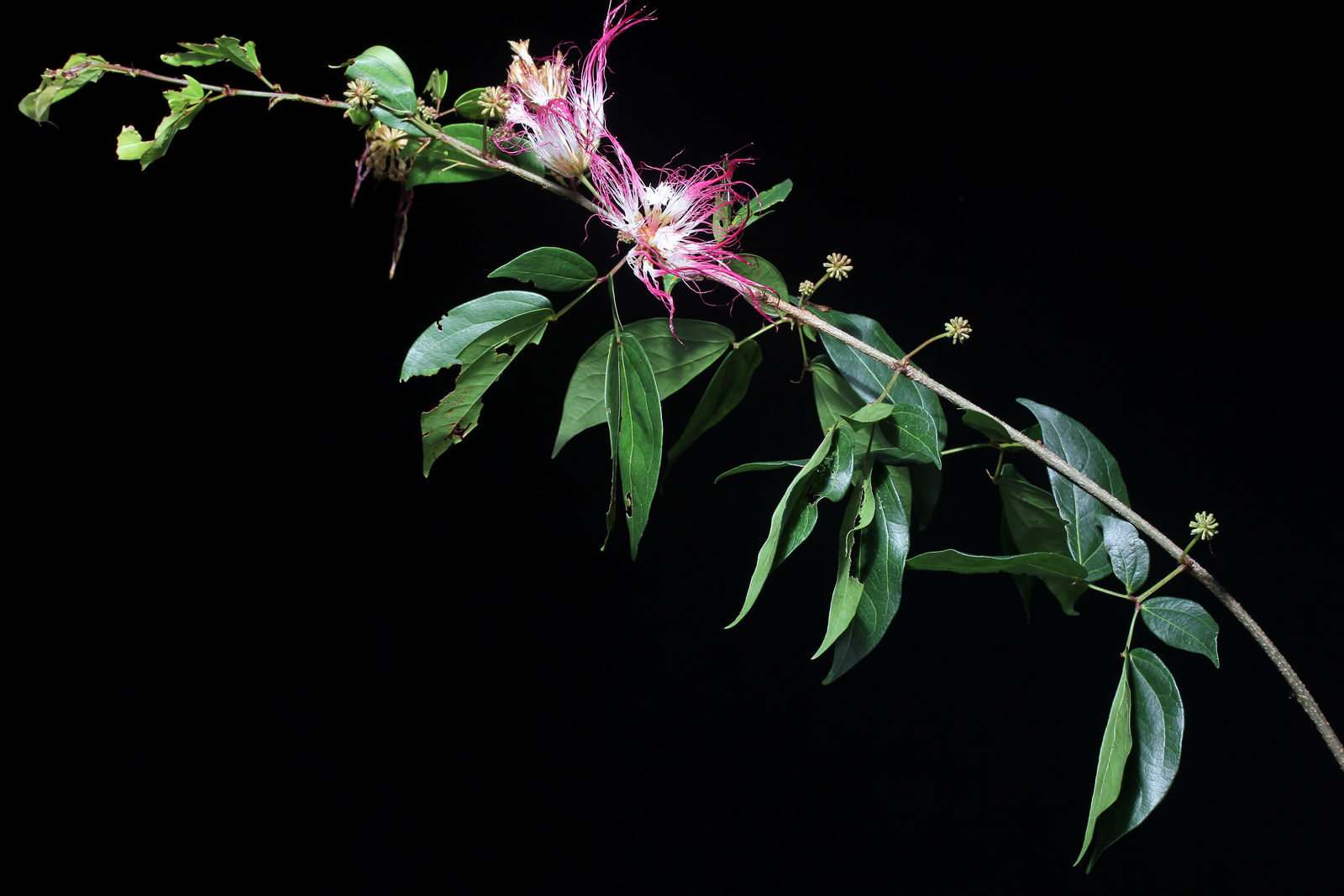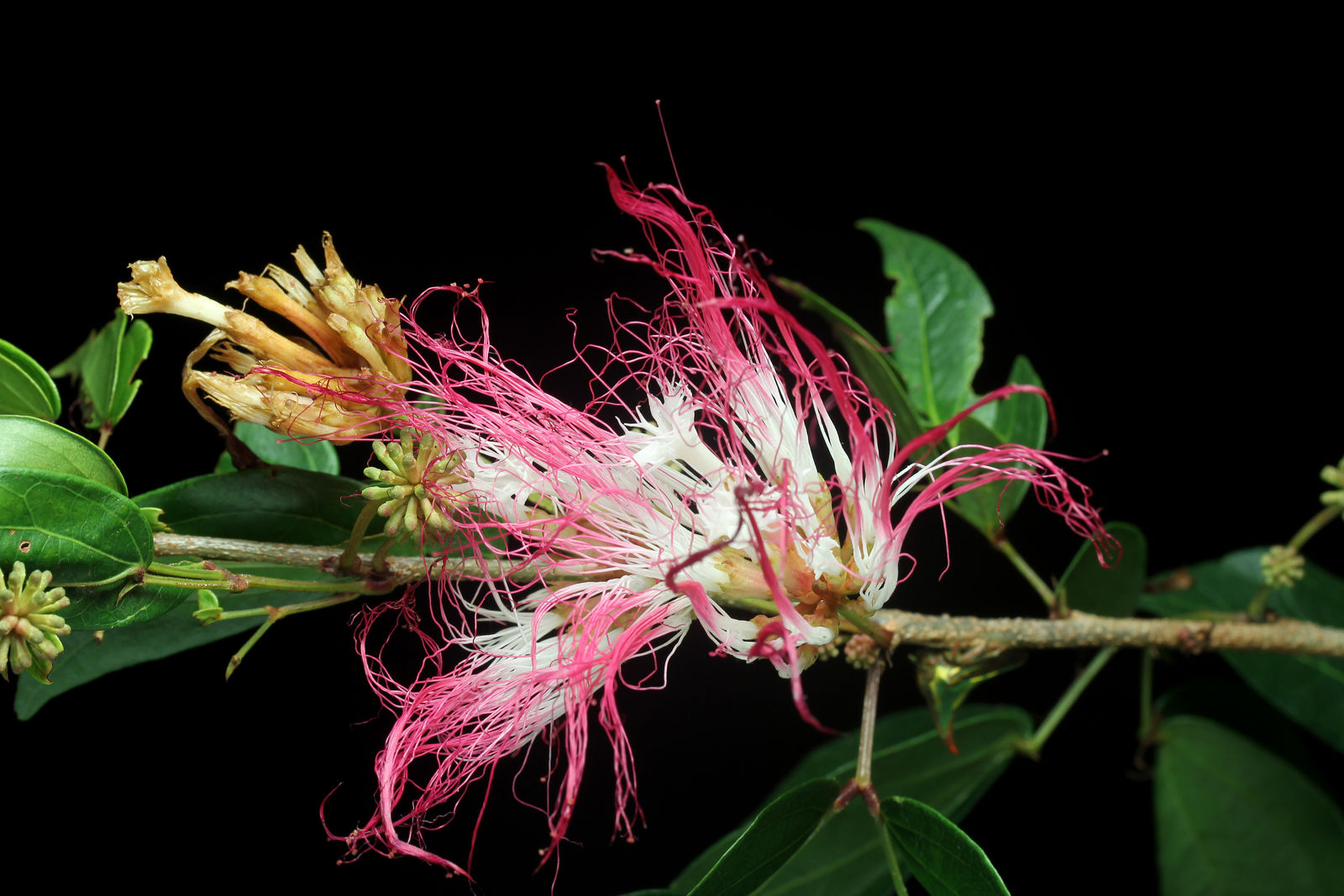Three-awned Calliandra
calliandra tergemina
Also known as: ["Three-awned Powderpuff"]
Overview
A deciduous shrub native to tropical and subtropical regions, known for its delicate, feathery flowers.
Benefits & Perks
["fragrant flowers","wildlife attractant (bees, butterflies, birds)"]
Botanical Classification
| Phylum: | Magnoliophyta |
| Class: | Magnoliopsida |
| Order: | Fabales |
| Family: | Fabaceae |
| Genus: | Calliandra |
| Botanical Name: | Calliandra tergemina |
Plant Characteristics
Basic Information
- Category: Flowers
- Suitable Location: outdoor garden bed in warm, sheltered area
- Suitable For:
- Is Weed: No
- Allergenicity: low
Environmental Needs
- Climate: {"temperatureRange":"15–30°C"}
- Hardiness: {"zones":"9–11"}
- Misting: every 2–3 days in dry environments, less often in humid climates
- Drainage: Fast-draining to prevent waterlogging.
- Soil Type: Well-draining potting mix with added perlite or sand.
Maintenance Level
- Maintenance Level: moderate
- Toughness Level: moderate
- Pruning Frequency: Light pruning every 2–3 months; major pruning in late winter or early spring.
- Pruning Intensity: Moderate; remove up to one-third of growth if needed for shaping or rejuvenation.
Care Details
Ideal Sunlight Coverage:
Bright indirect light for 6–8 hours daily; can tolerate some direct morning sun but avoid harsh afternoon sun.
Sunlight Tolerance Tips:
Acclimate gradually to direct light; protect from intense midday sun; adjust placement based on indoor/outdoor conditions.
Care Requirements
Care Difficulty
moderatemoderate
Sunlight
full sun to partial shade
Rotate plant weekly for even growth; use sheer curtains to filter intense light; move outdoors in spring/summer for stronger light.
Watering
every 7–10 days during active growth, reduce in winter
Water thoroughly until it drains from the bottom; allow soil to dry between waterings; avoid overwatering.
Soil
well-draining, sandy loam with moderate organic content
pH: Slightly acidic to neutral (pH 6.0–7.0).
Ensure pots have drainage holes; avoid heavy clay soils; top-dress with compost annually.
Temperature
Prefers 65–85°F (18–29°C); tolerates mild fluctuations but avoid prolonged exposure to extreme temperatures.
Protect from frost; maintain consistent temperatures; avoid placing near heating/cooling vents.
Fertilizing
every 4–6 weeks during growing season, none in winter
Fertilize after watering to prevent root burn; flush soil occasionally to remove salt buildup; adjust based on plant response.
Propagation
Methods
Stem cuttings in spring/summer.
Step-by-Step Propagation Guide
- Take a 4–6 inch cutting.
- Remove lower leaves.
- Dip in rooting hormone.
- Plant in medium.
- Maintain humidity.
Best Time: Spring or early summer when the plant is actively growing.
Environment
High humidity (70–80%), warm temperatures (70–75°F), and indirect light.
Medium
Well-draining mix of peat, perlite, and sand.
Hormone
Rooting hormone is recommended for faster root development.
Timeline
Roots develop in 4–8 weeks; new growth appears in 2–3 months.
Tools Needed
Pruning shears, rooting hormone, small pots, plastic wrap or propagator.
Quick Tips
Use healthy, non-flowering stems; keep soil consistently moist; provide bottom heat for faster rooting.
Pruning & Repotting
Pruning Guide
Method
Pinch back tips for bushiness; cut just above a leaf node or bud.
Pruning Plan
Shape the plant, encourage bushier growth, and remove dead/damaged stems.
Tools
Sharp pruning shears, sterilized scissors.
Checklist
Sterilize tools; prune dead/damaged stems; shape as desired; clean up debris.
Repotting Guide
Best Season
Early spring before new growth begins.
Pot Size
Increase pot size by 2–3 inches in diameter.
Method
Remove plant gently; trim roots if necessary; place in new pot with fresh soil; water lightly.
Suggestions
Repot every 2–3 years or when roots fill the pot; beneficial for growth and soil freshness.
Checklist
Check root bound status; prepare new pot; use fresh soil; water after repotting.
Advanced Care Tips
Watering Mastery
Watering Checklist
Check soil moisture; water thoroughly; ensure drainage; adjust for season.
How to Apply Water Properly
Water directly at the root zone, ensuring even saturation; water early in the morning to reduce evaporation; ensure excess water drains away.
Watering Schedule Tips
Water deeply once the top inch of soil feels dry; reduce frequency in winter to prevent root rot.
Soil Improvement
Add perlite or coarse sand for drainage; incorporate organic matter like compost for fertility.
Temperature Stress Management
Signs of Temperature Issues
Leaf drop, wilting, yellowing, or stunted growth; buds may fail to open in cold stress.
Cold Stress
Slows growth, causes leaf drop, and may lead to root damage if temperatures drop below 50°F (10°C).
Solution: Move to a warmer location; insulate roots with mulch; avoid cold drafts and sudden temperature drops.
Hot Stress
Leaves may scorch, wilt, or drop; growth may slow due to excessive heat and water loss.
Solution: Provide shade during peak heat; increase humidity; water more frequently but avoid waterlogging.
Fertilizing Guide
Fertilizing Checklist
Check season; dilute fertilizer; apply to moist soil; monitor for signs of over/under-fertilization.
Fertilizing Method
Use balanced liquid fertilizer diluted to half strength every 4–6 weeks during growing season (spring/summer); cease in fall/winter.
Common Problems & Solutions
Toxicity Warning
Cats
Non-toxicCalliandra tergemina is not known to be toxic to cats. It does not pose a significant risk if ingested or handled.
⚡ Toxic If:
None
Dogs
Non-toxicCalliandra tergemina is not known to be toxic to dogs. It does not pose a significant risk if ingested or handled.
⚡ Toxic If:
None
Humans
Non-toxicCalliandra tergemina is not known to exhibit toxic properties to humans. It is generally considered safe for handling and consumption.
⚡ Toxic If:
None
Frequently Asked Questions
Q: Does Calliandra tergemina require full sun?
A: Yes, it thrives in full sun to partial shade.
Q: How often should it be watered?
A: Water moderately, allowing the soil to dry slightly between waterings.
Q: Is it suitable for container gardening?
A: Yes, but ensure it has adequate space to grow and proper drainage.
Quick Reference
| Family: | Fabaceae |
| Care: | moderate |
| Light: | full sun to partial shade |
| Water: | every 7–10 days during activ |
Get Expert Care Tips
Download the Plantious app for personalized care reminders and plant identification!
Google Play App Store








